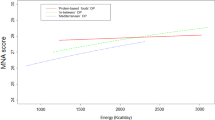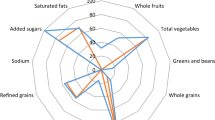Abstract
Objectives:
To identify dietary patterns of urban Beninese adults and explore their links with overall diet quality and socio-demographics.
Subjects and methods:
A sample of 200 men and women aged 25–60 years was randomly selected in 10 neighbourhoods. Food intake was assessed through three non-consecutive 24 h food recalls. Dietary patterns were examined using cluster analysis. Diet quality was assessed based on diversity, a micronutrient adequacy score (MAS) and a healthfulness score (HS). Socio-demographics were documented using a questionnaire.
Results:
Two distinct dietary patterns emerged: a ‘traditional’ type (66% of the subjects) and a ‘transitional’ type (34%). Subjects with a ‘transitional diet’ were predominantly from the upper socioeconomic status or born in the city. Compared with the traditional type, the ‘transitional diet’ had a significantly higher percentage of energy from fat (17.6 vs 15.5%), saturated fat (5.9 vs 5.2%) and sugar (6.3 vs 5.0%). It was also significantly higher in cholesterol and lower in fibre. The ‘transitional diet’ was more diversified, but it also showed a lower HS than the ‘traditional diet’. Mean intake of fruit was low in both clusters (<16 g day−1). A higher intake of vegetables was associated with both a higher MAS (P<0.001) and a higher HS (P<0.001).
Conclusions:
The dietary transition is evidenced in this study, although both dietary patterns were still low in fat and sugar. Programmes focusing on the prevention of diet-related chronic diseases in this population should encourage the maintenance of the healthful elements of the diets, while emphasizing consumption of fruits and vegetables.
This is a preview of subscription content, access via your institution
Access options
Subscribe to this journal
Receive 12 print issues and online access
$259.00 per year
only $21.58 per issue
Buy this article
- Purchase on Springer Link
- Instant access to full article PDF
Prices may be subject to local taxes which are calculated during checkout

Similar content being viewed by others
References
Calloway DH, Murphy SP, Bunch S, Woerner J (1994). WorldFood 2 dietary assessment system. FAO web site. Available at http://www.fao.org/infoods(Accessed September 2006).
Conway JM, Ingwersen LA, Moshfegh AJ (2004). Accuracy of dietary recall using five-step-multiple-pass method in men: an observational validation study. J Am Diet Assoc 104, 595–603.
Crozier SR, Robinson SM, Borland SE, Inskip HM, The SWS Study Group (2006). Dietary patterns in the Southampton women's. Eur J Clin Nutr 60, 1391–1399.
EDSB (2001). Enquête démographique et de santé du Bénin. Rapport final. Institut National de la Statistique et de l’Analyse Économique: Cotonou.
Everitt B, Landau S, Leese M (2001). Cluster Analysis, 4th edn. Edward Arnold Publishers Ltd: London.
FAO/WHO (2001). Human vitamin and mineral requirements. FAO: Roma. Report of a joint FAO/WHO expert consultation.
Himmelgreen D, Bretnall A, Perez-Escamilla R, Peng Y, Bermudez A (2005). Birthplace, length of time in the US, and language are associated with diet among inner-city Puerto Rican women. Ecol Food Nutr 44, 105–122.
Houweling TAJ, Kunst AE, Mackenbach JP (2003). Measuring health inequality among children in developing countries: does the choice of the indicator of economic status matter? Int J Equity Health 2, 8.
Hu FB (2002). Dietary pattern analysis: a new direction in nutritional epidemiology. Curr Opin Lipidol 13, 3–9.
Institut National de la Statistique et de l’Analyse Économique (INSAE) (2003). Troisième Recensement Général de la Population et de l’Habitat. Direction des Études Démographiques: Cotonou.
Institute of Medicine Food and Nutrition Board (2000). Dietary Reference Intakes for Vitamin A, Vitamin E, Selenium and Carotenoids. National Academy Press: Washington, DC.
Jacques PF, Tucker K (2001). Are dietary patterns useful for understanding the role of diet in chronic disease? Am J Clin Nutr 73, 1–2.
Kant AK (1996). Indexes of overall diet quality: a review. J Am Diet Assoc 96, 785–791.
Kant AK, Graubard BI, Schatzkin A (2004). Dietary patterns predict mortality in a national cohort: the national health interview surveys, 1987 and 1992. J Nutr 134, 1793–1799.
Kim S, Haines PS, Siega-Riz AM, Popkin BM (2003). The diet quality index-international provides an effective tool for cross-national comparison of diet quality as illustrated by China and the United States. J Nutr 133, 3476–3484.
Liese AD, Schulz M, Moore CG, Mayer-Davis EJ (2004). Dietary patterns, insulin sensitivity and adiposity in the multi-ethnic insulin resistance atherosclerosis study population. Br J Nutr 92, 973–984.
Martikainen P, Brunner E, Marmot M (2003). Socioeconomic differences in dietary patterns among middle-aged men and women. Soc Sci Med 56, 1397–1410.
Nusser SM, Carriquiry AL, Dodd K, Fuller WA (1996). A semiparametric transformation approach to estimating usual daily intake distributions. J Acoust Soc Am 91, 1440–1449.
Ponce X, Ramirez E, Delisle H (2006). A more diversified diet among Mexican men may also be more atherogenic. J Nutr 136, 2921–2927.
Popkin BM (2002). An overview on the nutrition transition and its health implications: the Bellagio meeting. Public Health Nutr 5, 93–103.
Ritenbaugh C, Szathmary EJ, Goodby CS, Feldman C (1996). Dietary acculturation among the Drogib Indians of the Canadian Northwest Territories. Ecol Food Nutr 35, 81–94.
Ruel MT (2003). Operationalizing dietary diversity: a review of measurement issues and research priorities. J Nutr 133, S3911–S3926.
Savy M, Martin-Prével Y, Sawadogo P, Kameli Y, Delpeuch F (2005). Use of variety/diversity for diet quality measurement: relation with nutritional status of women in a rural area in Burkina Faso. Eur J Clin Nutr 59, 703–716.
Sodjinou RS (2006). Evaluation of food composition tables commonly used in Benin: limitations and suggestions for improvement. J Food Compos Anal 19, 518–523.
Song Y, Joung H, Engelhardt K, Yoo SY, Paik HY (2005). Traditional vs modified dietary patterns and their influence on adolescents’ nutritional profile. Br J Nutr 93, 943–949.
Stunkard AJ (2000). Factors in obesity: currents views. In: M Pena, J Bacallao (eds). Obesity and Poverty: A New Public Health Challenge. Pan American Health Organization: Washington, DC, pp 23–28.
Szathmary EJ, Ritenbaugh C, Goodby CS (1987). Dietary changes and plasma glucose levels in an Amerindian population undergoing cultural transition. Soc Sci Med 24, 791–804. (abstract).
Thiam I, Samba K, Lwanga D (2006). Diet related chronic disease in the West Africa Region. SCN News 33, 6–10.
Torheim LE, Ouattara F, Diarra MM, Thiam FD, Barikmo I, Hatloy A et al. (2004). Nutrient adequacy and dietary diversity in rural Mali: association and determinants. Eur J Clin Nutr 58, 594–604.
Villegas R, Salim A, Collins MM, Flynn A, Perry IJ (2004). Dietary patterns in middle-aged Irish men and women defined by cluster analysis. Public Health Nutr 7, 1017–1024.
WHO/FAO (2003). Diet, nutrition and prevention of chronic diseases. Report of a joint WHO/FAO expert consultation. Report no. 916. WHO: Geneva.
WHO (2007). Obesity and overweight. WHO web site. Available at http://www.who.int/dietphysicalactivity/publications/facts/obesity/en/(Accessed February 2007).
Willet W (1998). Nutritional Epidemiology 2nd edn. Oxford University Press: New York.
Acknowledgements
We gratefully acknowledge the fieldworkers, Ossénatou Taïrou, Armand Agloboé, Hubert Dédjan, Joël Acacha and Amzath Tidjani. The study was funded by the Canadian Institutes of Health Research (CIHR).
Author information
Authors and Affiliations
Corresponding author
Additional information
Guarantor: H Delisle.
Contributors: HD designed the study. RS collected the data under supervision of HD, BF and VA. RS and HD analysed the data and wrote the first draft of the paper. All the coauthors contributed to the revision and the finalization of the paper.
Rights and permissions
About this article
Cite this article
Sodjinou, R., Agueh, V., Fayomi, B. et al. Dietary patterns of urban adults in Benin: relationship with overall diet quality and socio-demographic characteristics. Eur J Clin Nutr 63, 222–228 (2009). https://doi.org/10.1038/sj.ejcn.1602906
Received:
Revised:
Accepted:
Published:
Issue Date:
DOI: https://doi.org/10.1038/sj.ejcn.1602906
Keywords
This article is cited by
-
Dietary patterns and their socioeconomic factors of adherence among adults in urban Burkina Faso: a cross-sectional study
Journal of Health, Population and Nutrition (2023)
-
Dietary quality in rural areas, secondary towns, and cities: Insights from Tanzania
Food Security (2023)
-
Factors influencing dietary practices in a transitioning food environment: a cross-sectional exploration of four dietary typologies among rural and urban Ugandan women using Photovoice
Nutrition Journal (2020)
-
Dietary intake in undernourished adults living in Guinea-Bissau; a cross-sectional study
BMC Nutrition (2019)
-
Micronutrient intakes and status assessed by probability approach among the urban adult population of Hyderabad city in South India
European Journal of Nutrition (2019)



